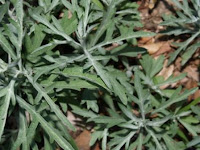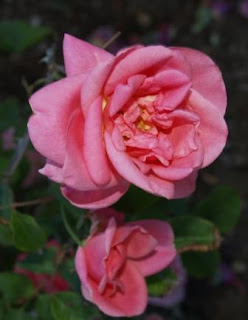The plant genus Artemisia was named after the Greek goddess Artemis
The perennial Artemisias spread by underground runners and make very useful ground cover plants .They are briefly dormant in Winter though there is obviously much activity below ground because when they reappear in Spring it is often a metre away from where you originally planted them.The foliage is soft and feathery and ,though usually silver, the cultivar 'Lemon and Lime' is cream ,green and gold and is very bright . It is very useful to lighten a shady corner of the garden.

Artemesia 'Lemon and Lime' with purple Tradescantia pallidaThis Artemisia also weaves it way around other plants without ever becoming invasive .Here it is growing around Aechmea recurvata aurea, a spiny sun hardy and frost hardy bromeliad.
 It also looks good with Geranium 'Rozanne' PBR which produces large saucer shaped purple flowers for much of the year. Geranium 'Rozanne' is a hybrid between G.wallichianum and G.himaleyense and is a very tough plant performing well on the coast and in the mountains.
It also looks good with Geranium 'Rozanne' PBR which produces large saucer shaped purple flowers for much of the year. Geranium 'Rozanne' is a hybrid between G.wallichianum and G.himaleyense and is a very tough plant performing well on the coast and in the mountains.

Geranium 'Rozanne' PBR
 Artemisia in flower during Summer
Artemisia in flower during Summer
When the Artemisias flower they produce tall feathery plumes which are quite decorative and useful as cut flowers. They also provide a bit of shade for some of the sun hardy Bromeliads , the blade shaped leaves of which may scorch on the very hottest of days.

Artemisia ludoviciana 'Valerie Finnis'
The one Artemisia which deserves special mention is A. dracunculus or French Tarragon . It is a favourite herb, as the use of just one leaf is sufficient to give flavour to a dish especially when used in the cooking of chicken. "Dracunculus" means dragon-tail alluding to the serpent coil of roots from this plant. The new shoots are just making an appearance now.
2017 update: I no longer grow the 'Lemon and Lime Artemisia but have a range of other species and cultivars. I also currently have stock of Geranium 'Rozanne'


